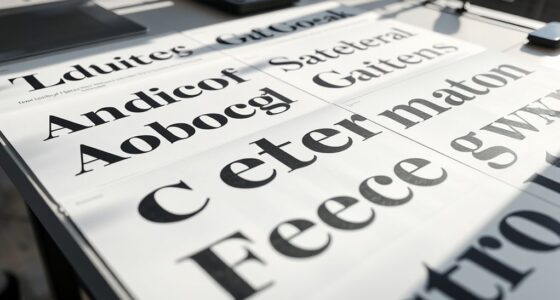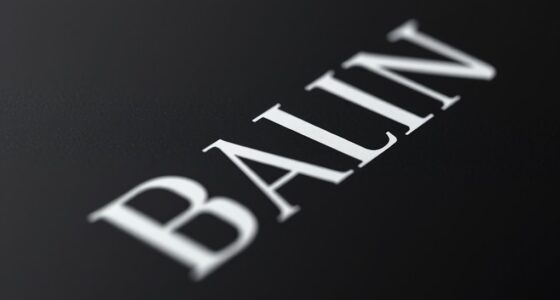Kerning adjusts the space between specific letter pairs to improve visual harmony and readability, especially in logos or headlines. Tracking, however, changes the overall spacing across entire words or lines, affecting the density and flow of text. Proper use of both creates a balanced, professional look. Knowing when to tweak kerning versus tracking helps your typography look polished. To master these subtle but powerful differences, you’ll find more detailed insights as you explore further.
Key Takeaways
- Kerning adjusts space between specific letter pairs, while tracking changes spacing uniformly across entire words or lines.
- Kerning fine-tunes visual balance between individual characters; tracking affects overall text density and readability.
- Proper kerning enhances letter shape harmony and clarity; tracking influences the overall flow and cohesion of text blocks.
- Kerning corrections are used in logo design and headlines; tracking is often applied to large text or paragraphs for impact.
- Both improve visual harmony and professionalism but serve different purposes in adjusting letter spacing.
Defining Kerning and Its Purpose
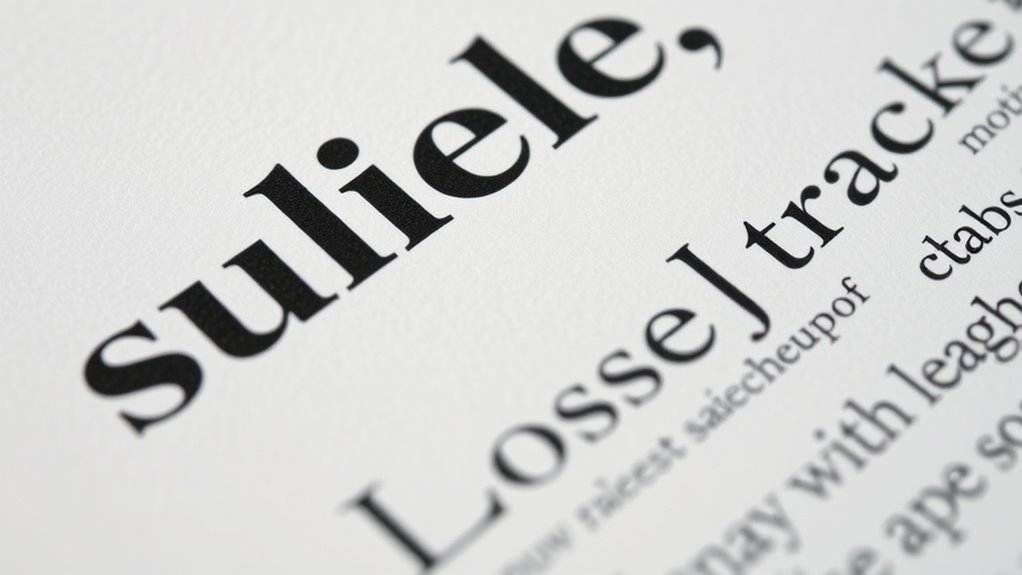
Have you ever noticed how some text looks perfectly balanced while other times it feels cramped or uneven? That’s where kerning comes in. Kerning adjusts the space between specific pairs of letters to improve letter spacing and create a more harmonious visual flow. Its purpose is to enhance typographic balance, making the text easier to read and more visually appealing. Unlike tracking, which affects spacing uniformly across an entire word or line, kerning targets individual letter pairs. This fine-tuning prevents awkward gaps or overly tight spacing that can disrupt the overall look. When kerning is done well, your text appears more polished, professional, and comfortable for the reader. Proper headphone connection, such as using the correct jack type or wireless pairing, can also contribute to an optimal listening experience. It’s a subtle but essential aspect of creating visually pleasing typography.
Understanding Tracking and Its Role in Typography
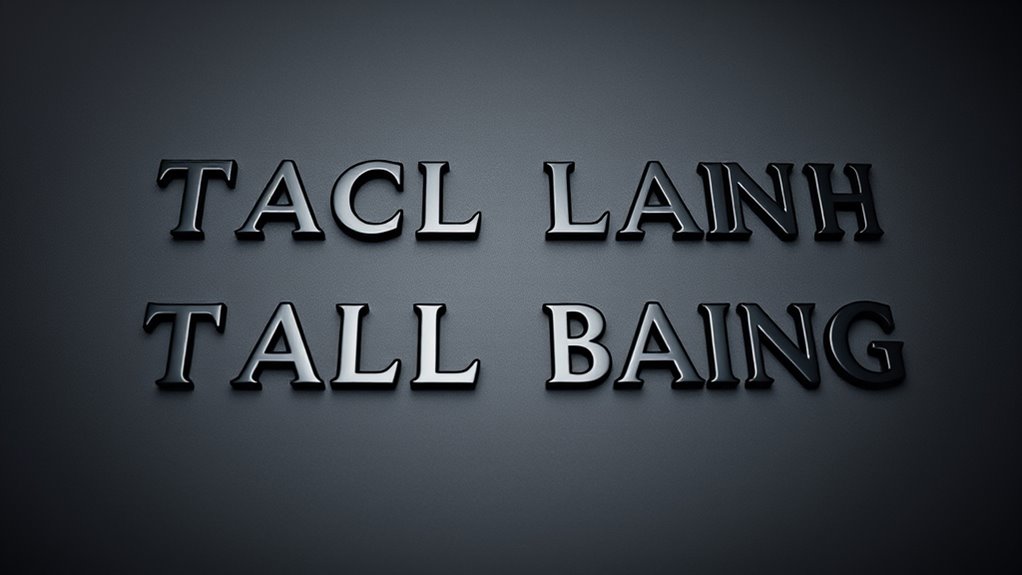
While kerning focuses on adjusting space between specific letter pairs, tracking involves changing the spacing across an entire word or line. Tracking influences the overall density and readability of your text, making it a crucial tool in typography history. Proper tracking ensures your design feels balanced and harmonious, especially when experimenting with font pairing. Too tight or too loose, and your message can become hard to read or visually unappealing. Understanding tracking helps you create professional layouts for print and digital media. It also allows you to tailor your typography to suit different contexts, from elegant invitations to modern websites. Mastering this concept enhances your ability to craft visually engaging and legible text. Additionally, awareness of typography and design history can provide valuable insight into effective tracking practices, helping designers develop a more cohesive visual language. Recognizing how space management impacts overall design can further refine your typographic choices. A solid grasp of letter spacing techniques can elevate your overall design skillset and communication effectiveness. Furthermore, understanding the individual responses of children to various emotional situations can inform more empathetic design choices, even in visual communication.
The Visual Impact of Proper Kerning
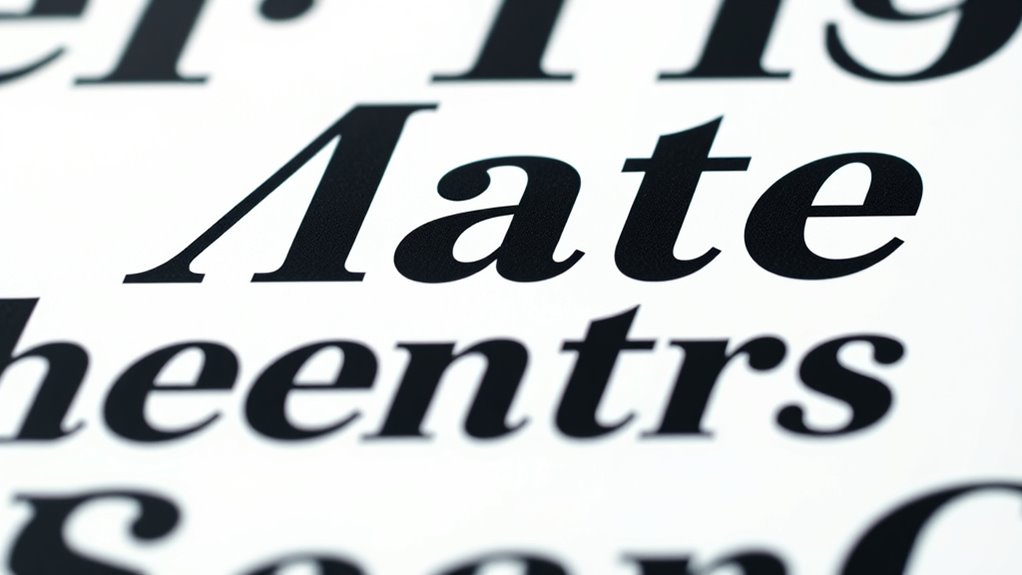
Proper kerning dramatically enhances a design‘s visual harmony by ensuring that each letter pair interacts seamlessly. When letter spacing is carefully adjusted, your text appears more balanced and professional, capturing attention effortlessly. Good kerning prevents awkward gaps or overlaps that can distract the reader, making your message clearer. It also plays a crucial role in font pairing, as well-chosen kerning helps different typefaces work together smoothly. This attention to detail creates a cohesive look, elevating your overall design. Whether you’re designing a logo, headline, or body text, proper kerning guarantees that your typography looks intentional and polished. Ultimately, it influences how your audience perceives your brand, making your message more engaging and trustworthy. Additionally, understanding the vibrational energy behind your design choices can further optimize the emotional impact of your typography.
How Tracking Influences Overall Text Appearance

Tracking, the overall adjustment of space between groups of letters, markedly shapes the look and feel of your entire text. When you modify letter spacing, you influence how readable and cohesive your content appears. Proper tracking guarantees font consistency, making your text look polished and professional. Increasing letter spacing can create an airy, elegant vibe, while decreasing it tightens the look for impact or urgency. It also affects the visual rhythm, guiding the reader’s eye smoothly across the page. Here are some ways tracking influences your text: Understanding the importance of consistent spacing helps maintain a balanced and professional appearance throughout your content. Additionally, just as well-designed water parks ensure a fun experience, precise tracking ensures your text provides a seamless reading experience without visual disruption. Paying attention to the overall appearance of your text can also help you achieve a more organized and appealing presentation. Moreover, maintaining proper tracking can support emotional alignment in your messaging, making your content more engaging and resonant with your audience. When combined with kerning adjustments, tracking helps refine the overall typographic harmony of your design.
Practical Examples of Kerning Adjustments

Adjusting kerning is a powerful way to improve the visual harmony of your text, especially in logo design, headlines, or any setting where individual letter pairs need fine-tuning. For example, when working with font pairing, you might tighten the spacing between letters in a bold sans-serif headline to create a more cohesive look. Similarly, in a logo, you can modify kerning to ensure that letter shapes complement each other, enhancing readability and aesthetic appeal. Pay attention to color contrast as well; proper kerning prevents letters from appearing crowded or disconnected, making your message clearer. Additionally, understanding regional divorce statistics can help designers tailor messages more effectively for different audiences. Recognizing how typography principles influence perception can lead to more impactful design choices. Small adjustments in kerning can dramatically influence the overall visual balance of your design, ensuring that your text feels balanced, professional, and visually engaging. Moreover, considering bike safety and maintenance tips can inspire creators to incorporate practical elements into their visual compositions, making designs both attractive and informative. Furthermore, being aware of indoor gardening options, such as unique planters, can inspire creative visual elements within your design projects.
When to Use Tracking in Your Design Projects
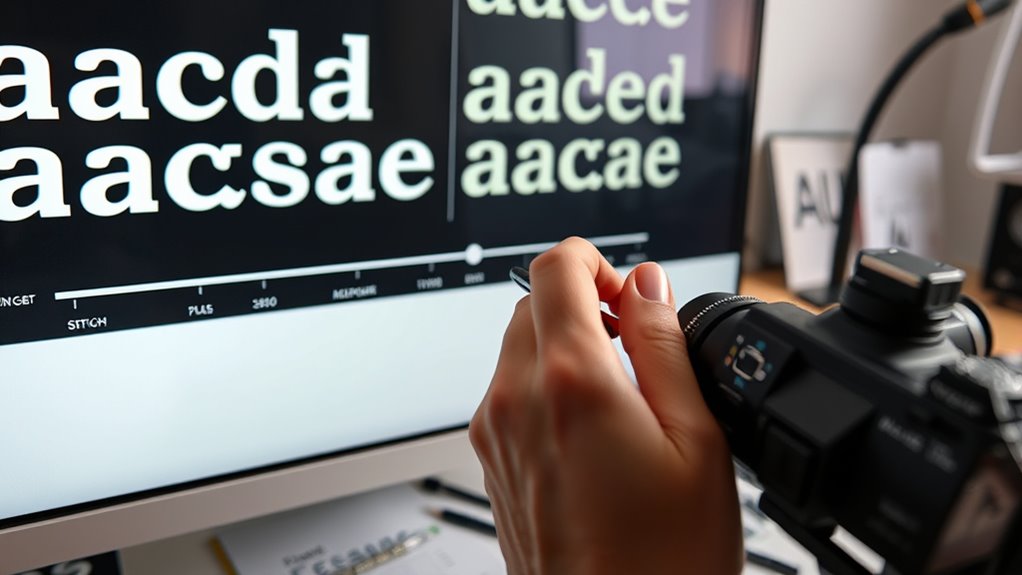
You should consider using tracking when you want to enhance overall readability or create a specific visual impact. Adjusting spacing can help your text stand out or blend seamlessly with other elements. Proper tracking also helps establish visual harmony, making your design more balanced and professional. Additionally, understanding yoga styles and techniques can inspire creative choices that reflect personality or style.
Enhancing Overall Readability
To enhance overall readability in your design projects, knowing when to apply tracking is essential. Proper tracking guarantees your text is easy to scan and understand, especially when considering font pairing and color contrast. Use increased tracking for headers or large text to create clarity and emphasis. Decrease tracking for tight, formal text to maintain professionalism. Adjust tracking when working with complex fonts or busy backgrounds to prevent visual clutter. Pay attention to font pairing to ensure spacing complements the overall style. Consider color contrast to make sure text stands out against backgrounds, reducing eye strain. Effective tracking balances readability without sacrificing aesthetics. Additionally, understanding how font choice influences spacing can help you fine-tune your designs for maximum clarity. Recognizing the impact of typography principles can further improve overall design harmony, especially when considering how letter spacing affects readability and visual appeal. Furthermore, applying evidence-based insights can guide you in making informed adjustments that enhance user experience and comprehension. Incorporating typography best practices ensures your design remains both functional and visually appealing.
Adjusting Spacing for Impact
When you want your text to make a strong visual impact, controlling the spacing with tracking becomes essential. Adjusting letter spacing helps create a bold or subtle effect, depending on your design goals. Use tracking when you need to improve the overall look of a block of text or when you want to emphasize a message without altering individual letter pairs. It’s especially useful for font pairing, where different fonts may require spacing adjustments to achieve harmony. Tracking can also enhance readability in headlines or display text by ensuring consistent spacing across characters. Knowing when to apply tracking allows you to manipulate the visual weight and tone of your project, making your message clearer and more compelling.
Creating Visual Harmony
Creating visual harmony with tracking involves knowing the right moments to adjust letter spacing so that your design feels cohesive and balanced. When you use tracking effectively, you can improve readability and create a unified look, especially in large blocks of text or headlines. Adjusting letter spacing helps you achieve the right flow between characters, making your font pairing seamless. Use tracking thoughtfully when combining fonts with different styles to prevent visual discord. It’s also useful for emphasizing certain words or creating a clean, uncluttered appearance. Keep in mind that subtle adjustments can make a big difference in overall harmony. Additionally, understanding how different toilet flushing mechanisms impact water efficiency can inform eco-conscious choices in bathroom design, emphasizing the importance of selecting the right system for your needs. Recognizing how typography principles influence overall design can further elevate your project’s visual appeal.
Common Mistakes and Misconceptions
Many people mistakenly believe that kerning and tracking are interchangeable, but this is a common misconception. This confusion often stems from typography myths that oversimplify how letter spacing works. In reality, kerning adjusts space between specific letter pairs to improve visual harmony, while tracking changes the overall spacing across a block of text. Misunderstanding these differences can lead to poor design choices, making text look awkward or unprofessional. One common font misconception is that increasing tracking always improves readability, but too much spacing can hinder comprehension. Conversely, neglecting kerning adjustments can cause uneven letter spacing, reducing legibility. Recognizing these distinctions helps you avoid these mistakes and creates cleaner, more polished typography.
Tips for Optimizing Letter Spacing in Your Work
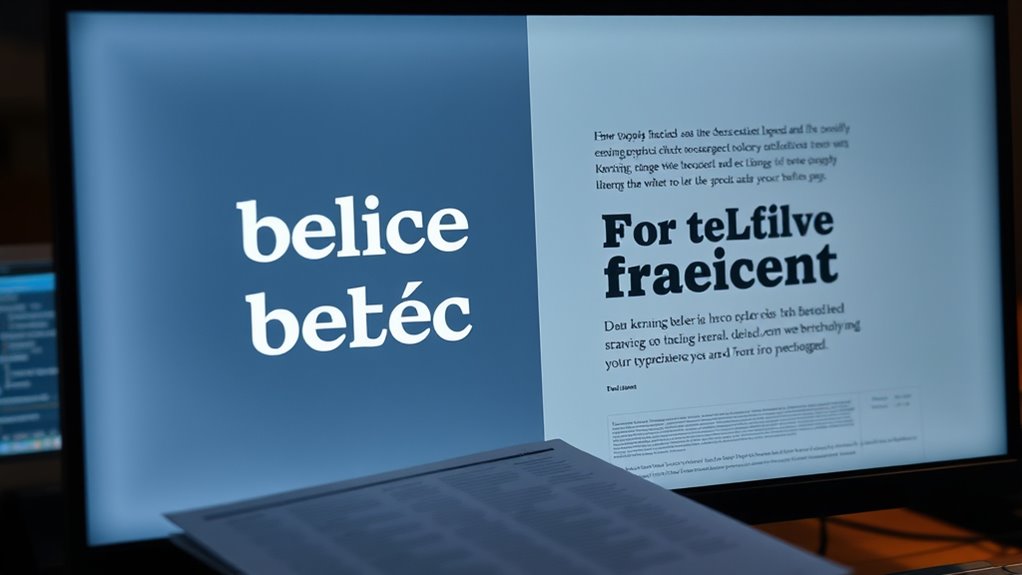
To optimize letter spacing effectively, start by paying close attention to the specific font you’re using, as different typefaces have unique spacing characteristics. Adjust tracking to create a balanced flow, especially when combining fonts with contrasting styles. Consider font pairing carefully to guarantee readability and harmony. Use color contrast wisely; high contrast between text and background makes spacing more noticeable. Regularly review your work at different sizes to assure clarity. Pay attention to the space around individual characters, especially in headlines or body text. Avoid over-kerning or excessive tracking, which can hinder readability. Test your design on various screens and print formats. Remember, subtle adjustments can substantially impact the overall aesthetic and effectiveness of your work.
Frequently Asked Questions
How Do Kerning and Tracking Differ in Practical Design Applications?
You adjust letter spacing to improve visual balance in your design, ensuring text is easy to read. Kerning focuses on customizing space between specific letter pairs for a polished look, while tracking involves uniformly changing spacing across an entire word or block of text. By understanding these differences, you can create harmonious typography that enhances readability and aesthetic appeal in your projects.
Can Improper Kerning or Tracking Affect Readability?
Improper kerning or tracking can greatly impact readability, disrupting typography consistency and visual harmony. When letter spacing is uneven, your text becomes harder to scan, causing readers to struggle with comprehension. Too tight or loose spacing distracts the eye, reducing clarity. To guarantee your message is clear and visually appealing, you need to adjust kerning and tracking carefully, maintaining consistent spacing that supports smooth reading and cohesive design.
Are There Tools Specifically for Adjusting Kerning and Tracking?
You’ll find that many typography software programs include adjustment tools specifically for kerning and tracking. These adjustment tools let you fine-tune the space between individual characters or entire blocks of text, improving readability and visual appeal. Popular software like Adobe InDesign and Illustrator offer intuitive controls for these adjustments. By using these tools, you guarantee your text looks professional, balanced, and easy to read, making your designs stand out.
How Does Font Type Influence Kerning and Tracking Adjustments?
When adjusting kerning and tracking, font type plays a vital role. Different fonts have unique shapes and spacing needs, affecting how you achieve effective font pairing and establish clear typographic hierarchy. You’ll find that some fonts require tighter kerning, while others need looser tracking for readability. Experimenting with these adjustments helps create balanced, professional-looking designs that communicate your message clearly and visually harmonize with other typefaces.
What Are Common Mistakes to Avoid With Kerning and Tracking?
Think of your font spacing as a dance; every move should be smooth and intentional. Common mistakes include over- or under-adjusting kerning and tracking, which can disrupt readability. Avoid inconsistent spacing that clashes with font pairing, making your design look unprofessional. Always check your spacing for consistency across different sizes and backgrounds, ensuring your text flows naturally and enhances your message without overpowering or underwhelming your audience.
Conclusion
mastering kerning and tracking transforms your typography from ordinary to breathtaking. When you fine-tune spacing, your text becomes more than just words—it’s a visual symphony that captures attention and leaves a lasting impression. Think of your letter spacing as the secret ingredient to creating designs that stand out in a sea of mediocrity. So, embrace these techniques, and watch your work shine brighter than a supernova, mesmerizing every eye that gazes upon it.




